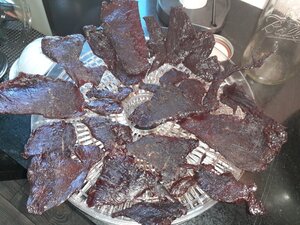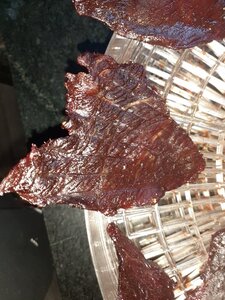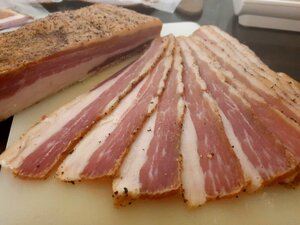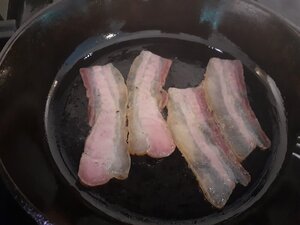Got another batch of jerky in the cold smoker.
Been dialing in my cold smoke time, today running 50/50 applewood and hickory chunks on a thin bed of BGE lump. Today it's raining and humid 76deg. Trying to run the smoker a little hot at about 87deg. To combat the humidity, It's tough to get this thing 10deg. Higher then ambient temp, it's a cold smoker after all.
Working on my recipe, this is roughly what I have going on per lb :
1/4tsp #1 pink
1 1/2tsp fine sea salt
1/2tsp fresh ground black pepper
1tsp garlic powder
1/2tsp dried onion flakes
1tbsp hoisen sauce
2tsp brown sugar
1tsp pure maple syrup
1tsp sriracha
2/3 cup warm water to whisk together
Been working on perfecting this one for years lol.
It's really good
I like to run 3/8" slices of extra lean top round
I vaccuum marinated for 26hrs, put it in the dehydrator for about 3 hours till it got tacky and loaded it up for a 2hr smoke then back into the dehydrator to finish.
I am just about finished the cold smoker build, got a indoor outdoor thermometer mounted up, put the wheels on it and added 2 adjustable height racks inside.
This thing is gonna see some serious meat, fish and cheese in the next few months, I will be posting.
Here is some pix.
Been dialing in my cold smoke time, today running 50/50 applewood and hickory chunks on a thin bed of BGE lump. Today it's raining and humid 76deg. Trying to run the smoker a little hot at about 87deg. To combat the humidity, It's tough to get this thing 10deg. Higher then ambient temp, it's a cold smoker after all.
Working on my recipe, this is roughly what I have going on per lb :
1/4tsp #1 pink
1 1/2tsp fine sea salt
1/2tsp fresh ground black pepper
1tsp garlic powder
1/2tsp dried onion flakes
1tbsp hoisen sauce
2tsp brown sugar
1tsp pure maple syrup
1tsp sriracha
2/3 cup warm water to whisk together
Been working on perfecting this one for years lol.
It's really good
I like to run 3/8" slices of extra lean top round
I vaccuum marinated for 26hrs, put it in the dehydrator for about 3 hours till it got tacky and loaded it up for a 2hr smoke then back into the dehydrator to finish.
I am just about finished the cold smoker build, got a indoor outdoor thermometer mounted up, put the wheels on it and added 2 adjustable height racks inside.
This thing is gonna see some serious meat, fish and cheese in the next few months, I will be posting.
Here is some pix.
Attachments
-
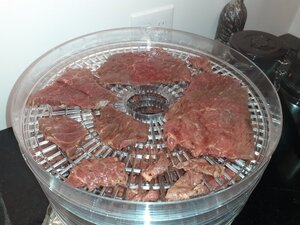 20200802_144152.jpg162 KB · Views: 77
20200802_144152.jpg162 KB · Views: 77 -
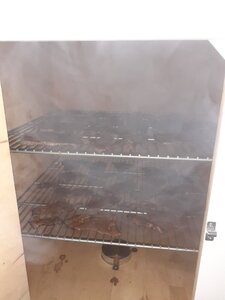 20200802_181842.jpg66.4 KB · Views: 78
20200802_181842.jpg66.4 KB · Views: 78 -
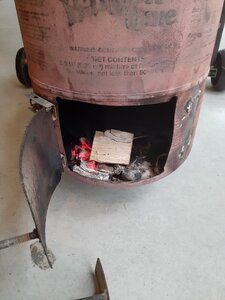 20200802_181949.jpg123.5 KB · Views: 75
20200802_181949.jpg123.5 KB · Views: 75 -
 20200802_182027.jpg151.5 KB · Views: 86
20200802_182027.jpg151.5 KB · Views: 86 -
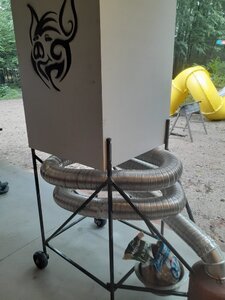 20200802_181935.jpg122.9 KB · Views: 87
20200802_181935.jpg122.9 KB · Views: 87 -
 20200802_182106.jpg95.5 KB · Views: 81
20200802_182106.jpg95.5 KB · Views: 81 -
 20200802_181919.jpg66.5 KB · Views: 77
20200802_181919.jpg66.5 KB · Views: 77 -
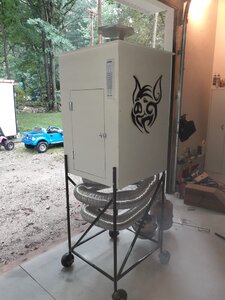 20200802_181816.jpg162 KB · Views: 80
20200802_181816.jpg162 KB · Views: 80 -
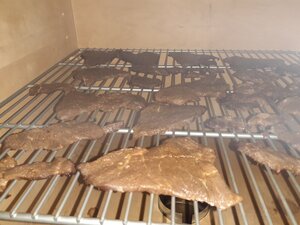 15964090582007719523629530485027.jpg119.9 KB · Views: 83
15964090582007719523629530485027.jpg119.9 KB · Views: 83


